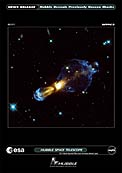Hubble reveals previously unseen shocks
This new, detailed, Hubble image shows a planetary nebula in the making of a proto-planetary nebula. A dying star (hidden behind dust and gas in the centre of the nebula) has ejected massive amounts of gas. Parts of the gas have reached tremendous velocities of up to one-and-a-half million kilometres per hour. Shown in blue is light from hydrogen and ionised nitrogen arising from supersonic shocks where the gas stream rams into the surrounding material. The image shows for the first time these complex gas structures which are predicted by theory. The Hubble image was taken shortly before Christmas 2000 with the WFPC2 instrument (Wide Field and Planetary Camera 2) in four different filters. Here, light from 791 nm is displayed in red (exposure time 900 s), 675 nm in green (900 s), while combined light from hydrogen (656 nm) and ionised nitrogen atoms (658 nm) are shown as blue (14, 700 s).
Credit:ESA & Valentin Bujarrabal (Observatorio Astronomico Nacional, Spain)
About the Image
| Id: | heic0111a |
| Type: | Observation |
| Release date: | 24 August 2001, 15:00 |
| Related releases: | heic0111 |
| Size: | 843 x 794 px |
About the Object
| Name: | Calabash Nebula, OH 231.8+4.2 |
| Type: | Milky Way : Nebula : Type : Planetary |
| Distance: | 4500 light years |
| Constellation: | Puppis |
| Category: | Nebulae |
Wallpapers
Coordinates
| Position (RA): | 7 42 16.37 |
| Position (Dec): | -14° 42' 55.46" |
| Field of view: | 1.40 x 1.32 arcminutes |
| Orientation: | North is 95.8° left of vertical |
Colours & filters
| Band | Wavelength | Telescope |
|---|---|---|
| Optical H-alpha + Nii | 658 nm |
Hubble Space Telescope
WFPC2 |
| Optical R | 675 nm |
Hubble Space Telescope
WFPC2 |
| Infrared I | 791 nm |
Hubble Space Telescope
WFPC2 |



